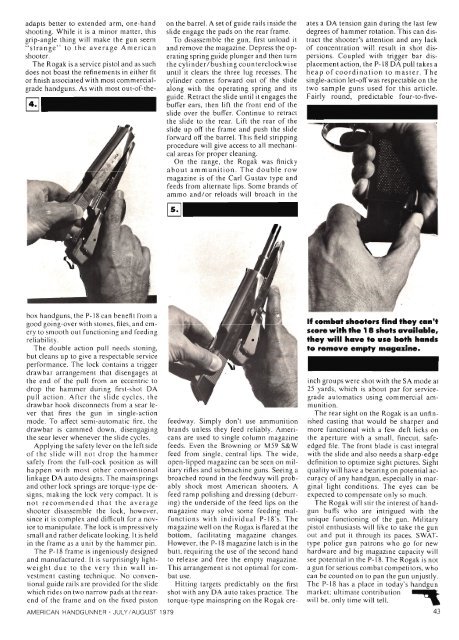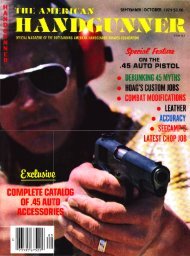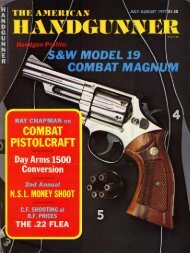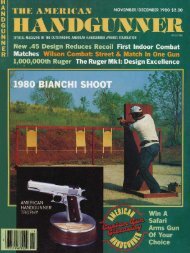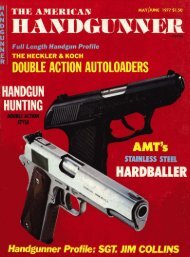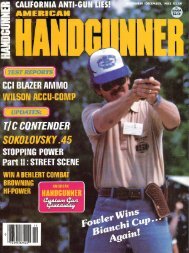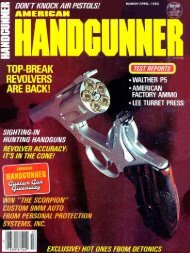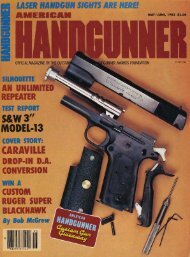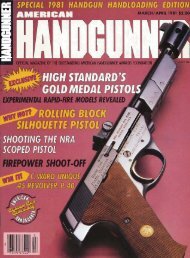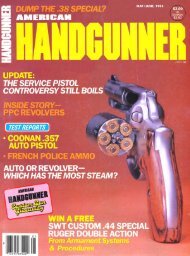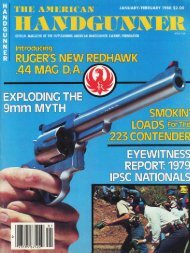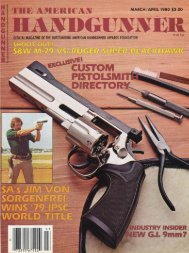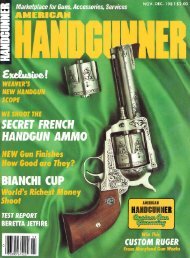American Handgunner July/August 1979
American Handgunner July/August 1979
American Handgunner July/August 1979
- No tags were found...
You also want an ePaper? Increase the reach of your titles
YUMPU automatically turns print PDFs into web optimized ePapers that Google loves.
on the barrel. A set ofguide rails inside theslide engage the pads on the rear frame.To disassemble the gun, first unload itand remove the magazine. Depress the operatingspring guide plunger and then turnthe cylinder/bushing counterclockwiseuntil it clears the three lug recesses. Thecylinder comes forward out of the slidealong with the operating spring and itsguide. Retract the slide until it engages thebuffer ears, then lift the front end of theslide over the buffer. Continue to retractthe slide to the rear. Lift the rear of theslide up off the frame and push the slideforward off the barrel. This field stri ppingprocedure will give access to all mechanicalareas for proper cleaning.On the range, the Rogak was finickyabout ammunition. The double rowmagazine is of the Carl Gustav type andfeeds from alternate lips. Some brands ofammo and/or reloads will broach in thefeedway. Simply don't use ammunitionbrands unless they feed reliably. <strong>American</strong>sare used to single column magazinefeeds. Even the Browning or M59 S&Wfeed from single, central lips. The wide,open-lipped magazine can be seen on militaryrifles and submachine guns. Seeing abroached round in the feedway will probablyshock most <strong>American</strong> shooters. Afeed ramp polishing and dressing (deburring)the underside of the feed lips on themagazine may solve some feeding malfunctionswith individual Pc l8's. Themagazine well on the Rogax is flared at thebottom, facilitating magazine changes.However, the P-18 magazine latch is in thebutt, requiring the use of the second handto release and free the empty magazine.This arrangement is not optimal for combatuse.Hitting targets predictably on the firstshot with any DA auto takes practice. Thetorque-type mainspring on the Rogak createsa DA tension gain during the last fewdegrees of hammer rotation. This can distractthe shooter's attention and any lackof concentration will result in shot dispersions.Coupled with trigger bar displacementaction, the P-18 DA pull takes aheap of coordination to master. Thesingle-action let-off was respectable on thetwo sample guns used for this article.Fairly round, predictable four-to-five-adapts better to extended arm, one-handshooting. While it is a minor matter, thisgrip-angle thing will make the gun seem"strange" to the average <strong>American</strong>shooter.The Rogak is a service pistol and as suchdoes not boast the refinements in either fitor finish associated with most commercialgradehandguns. As with most out-of-theboxhandguns, the P-18 can benefit from agood going-over with stones, files, and emeryto smooth out functioning and feedingreliability.The double action pull needs stoning,but cleans up to give a respectable serviceperformance. The lock contains a triggerdrawbar arrangement that disengages atthe end of the pull from an eccentric todrop the hammer during first-shot DApull action. After the slide cycles, thedrawbar hook disconnects from a sear leverthat fires the gun in single-actionmode. To affect semi-automatic fire, thedrawbar is cammed down, disengagingthe sear lever whenever the slide cycles.Applying the safety lever on the left sideof the slide will not drop the hammersafely from the full-cock position as willhappen with most other conventionallinkage DA auto designs. The mainspringsand other lock springs are torque-type designs,making the lock very compact. It isnot recommended that the averageshooter disassemble the lock, however,since it is complex and difficult for a noviceto manipulate. The lock is impressivelysmall and rather delicate looking. It is heldin the frame as a unit by the hammer pin.The P-18 frame is ingeniously designedand manufactured. It is surprisingly lightweightdue to the very thin wall investmentcasting technique. No conventionalguide rails are provided for the slidewhich rides on two narrow pads at the rearendof the frame and on the fixed pistonIf combat shooters find they can'tscore with the 18 shots available,they~iII have to use both handsto remove empty magazine.inch groups were shot with the SA mode at25 yards, which is about par for servicegradeautomatics using commercial ammunition.The rear sight on the Rogak is an unfinishedcasting that would be sharper andmore functional with a few deft licks onthe aperture with a small, finecut. safeedgedfile. The front blade is cast integralwith the slide and also needs a sharp-edgedefinition to optimize sight pictures. Sightquality will bave a bearing on potential accur~cyof any handgun, especially in marginallight conditions. The eyes can beexpected to compensate only so much.The Rogak will stir the interest of handgunbuffs who are intrigued with theunique functioning of the gun. Militarypistol enthusiasts will like to take the gunout and put it through its paces. SWATtypepolice gun patrons who go for newhardware and big magazine capacity willsee potential in the P-18. The Rogak is nota gun for serious combat competitors, whocan be counted on to pan the gun unjustly.The P-18 has a place in today's handgunmarket: ultimate contribution IIIIIMwillbe, only time will tell. ~AMERICAN HANDGUNNER . JULY / AUGUST <strong>1979</strong> 43


